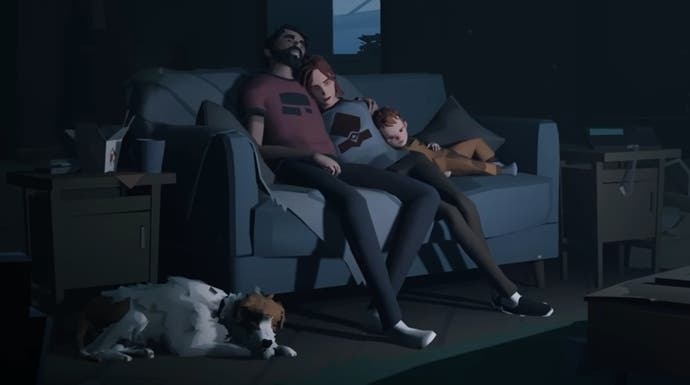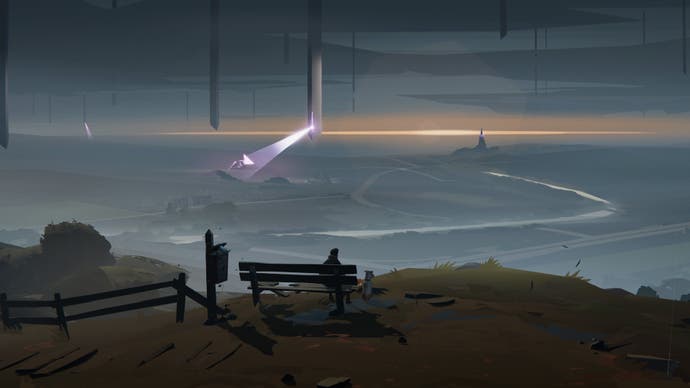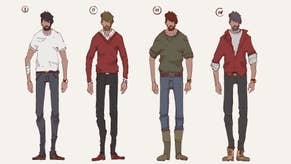Somerville review - a tasteful apocalypse with a little light puzzling
Family ties.
Oh, harmony. Look at those long, elegant limbs. A hero who is all sticks and elbows and knees, thin and drawn-in and desperate. I can just imagine the mechanics in play as he folds himself into the back seat of a car. And look! Look at the world around him, with its long thin alien craft in the sky, certainly, firing down lean graphite pencil strokes of death. But look as well at the low-poly landscape that is being ravaged, the buildings narrow and extended upwards, as if their tops had been gripped and given a good pull. A beanpole world in which a beanpole protagonist can stealth past beanpole enemies. Someone thought a long time about this. It's beautiful, strange, and coherent.
Somerville is pretty simple in theory. It's the alien apocalypse, viewed from the perspective of a family - two parents, a toddler, a dog - whose lives are upended by the invasion. The family is swiftly separated after the aliens descend and we follow the father as he heads out to find everyone again.
But I play it and other games intrude. For one thing, it's hard not to think of the likes of Limbo and Inside, since Jumpship, the studio behind Somerville, shares serious DNA with those games, and belongs, in a sense, to the genre they codified. You know, wordless, uncanny games about platforming and puzzling your way through stealthy terrorscapes. Somerville gives you a bit more freedom over the third-dimension - you can move into the screen as well as back and forth, allowing levels to spill in unexpected directions - but the beats are the same, and the air of desperation and sadness are the same too.
And yet, I find myself thinking of Another World as well, the Eric Chahi classic about a physicist dragged through a wormhole. There's the same attention to getting everything out of the chosen art aesthetic, and the same gloriously uneasy european take on sci-fi, the same cinematic staging, the same desire to make things look as good as possible, to be a stylish thing that is also a game.
What else? Half-Life, I think: bearded hero, sure, but also the sheer scale of the apocalypse going on around him, the same sense of being thoroughly outnumbered, all but defeated from the start, so all you can hope to do is scrabble onwards, out of your home, through the forest, down into the earth, and then?
This is unfair, I know, because Somerville has a lovely sense of itself, too. There's that extended, gangly art, and there's some brilliant set-piece staging, from a sequence where you have to run from a searing searchlight in the sky to another in which you race up a tower as enemies burst out around you in the darkness. It's not even the action stuff it can do nicely: there's a great moment in the middle of the game - it feels like the middle - in which you find yourself at a makeshift hospital, one refugee amongst others. The pace slows to the plod of human recovery, of people trying to get their bearings. Breathe out.

Somerville has its own ideas too. You don't just scramble from one side of the screen to another, you have limited power over alien matter that the invaders have left behind. It starts with lumps of voxelly red-tinged stone, the kind of thing Gary Numan might build cover art around. If you have a light source or electricity source you can use as an amplifier, you can squeeze a trigger to turn this stone into soupy blue voxelly liquid. So maybe you can clear an obstacle blocking your way, or make a path upwards.
Eventually, a squeeze of the other trigger will turn the soupy blue stuff back into stone, and here's where the puzzles really get going. Some of then are absolutely ingenious, including at least one that hinges on water displacement. At the very least, even the busywork puzzles allow you to guide your eye from one challenge to the next - a friendly bit of help enlivened by the use of the colour yellow on interactive objects.
The best puzzles lead to genuine a-ha moments, and use a wide range of items in the environments. The least inspired, though, often run aground of the fact that Somerville can be surprisingly fiddly. Maybe it's the shift to three dimensions, but the sluggish protagonist is not above getting stuck on things now and then, and occasionally even glitches out. These are all very rare occurrences, but the sad truth is that for long stretches Somerville isn't a very pleasing game to control: movement feels fuzzy and dreamlike in the worst sense - one of those dreams where you're wading, weighed down, pushing through the thick mineral air.
Minor annoyances when set against the things you get to see and the places you get to visit, perhaps. Somerville is a visual delight, taking the low-poly art style and using it to shatter a world and then send you through the remains. As a puzzle-platformer it's largely fine, but as a source of visual memories, it's often something else entirely.













